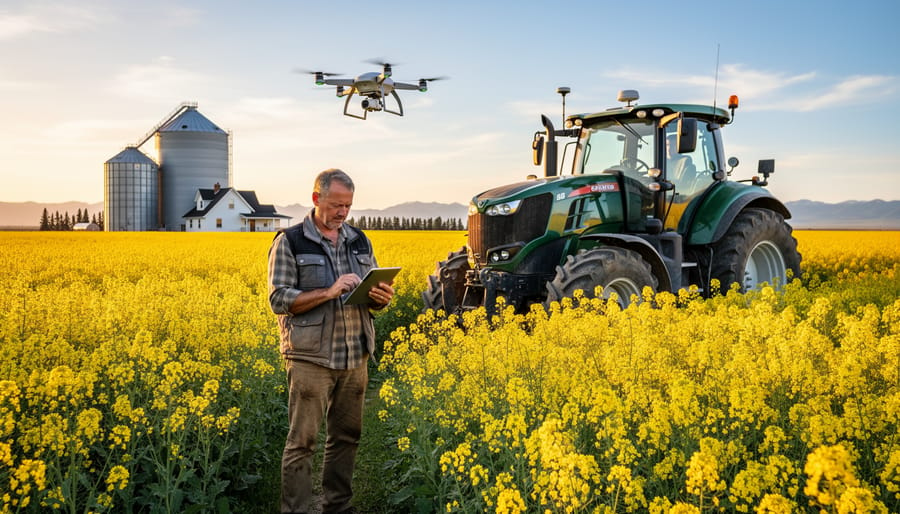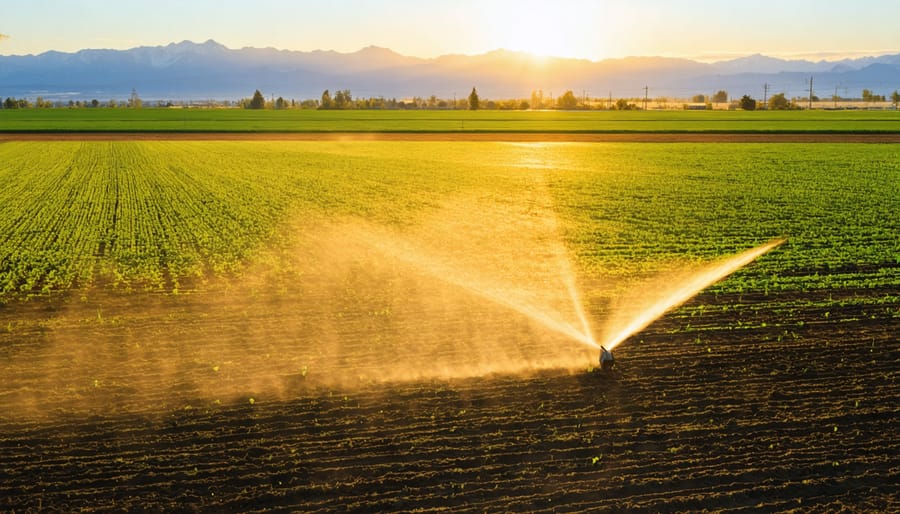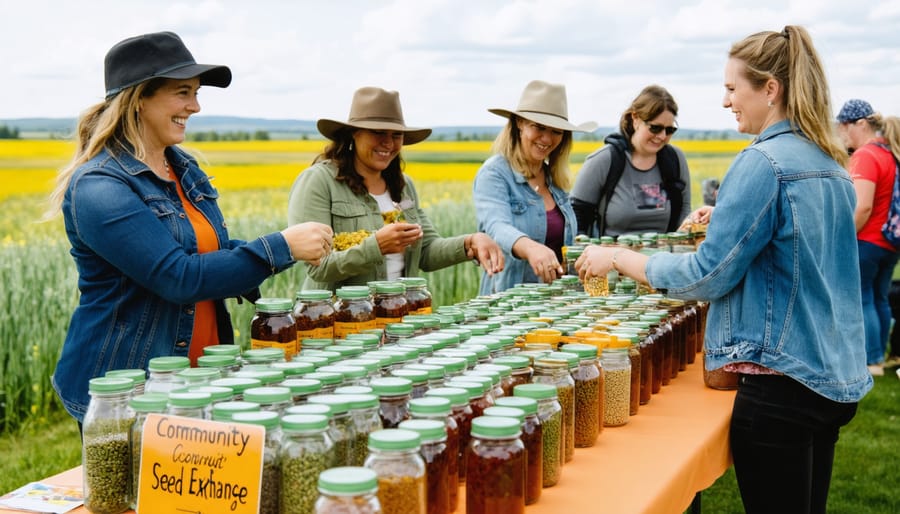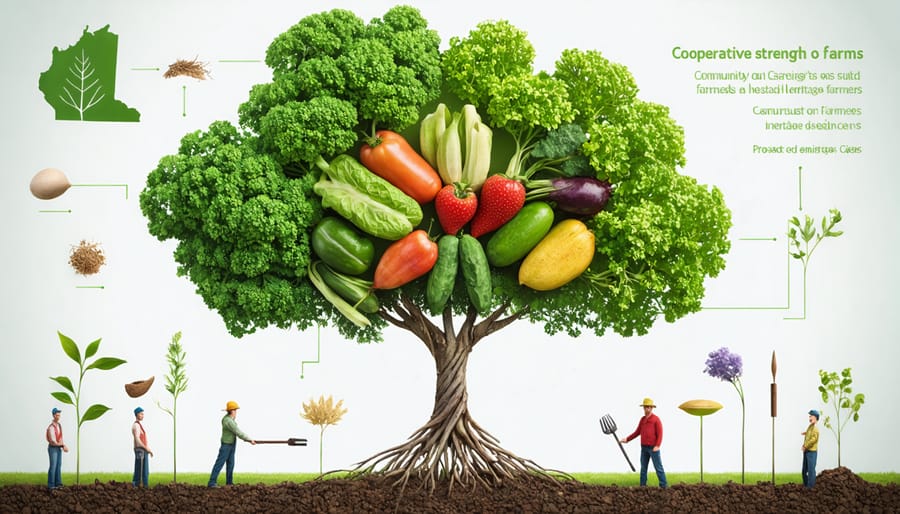In the heart of Alberta’s farming community, the Prairie Roots Collective has transformed 50 hectares of conventional farmland into a thriving example of smart agroforestry practices. This community-supported agriculture (CSA) initiative unites 120 local families with five experienced farmers, generating sustainable food production while building lasting community connections. By implementing a hybrid subscription model that combines seasonal harvests with year-round value-added products, the collective has achieved an impressive 85% member retention rate over three years. Their success demonstrates how traditional farming wisdom, combined with innovative distribution methods and strong community partnerships, can create resilient local food systems that benefit both producers and consumers. Through careful crop planning, transparent pricing structures, and regular member engagement events, Prairie Roots Collective offers a blueprint for aspiring CSA operators across Canada’s agricultural landscape.
The Woodland Edge Farm Success Story

From Traditional Farm to Forest Garden
The transformation of Prairie Roots Farm from a conventional grain operation to a thriving forest garden began in 2018 when Sarah McKenzie inherited her family’s 40-hectare property near Red Deer, Alberta. Recognizing the challenges of traditional farming and inspired by permaculture principles, McKenzie envisioned a sustainable agricultural system that would benefit both the environment and her local community.
The initial phase involved extensive community consultation, with McKenzie hosting informal gatherings at the local community centre to share her vision and gather input from potential stakeholders. These meetings attracted diverse participants, from experienced farmers to urban families seeking connection to their food source.
Working with local agricultural extension officers and permaculture experts, McKenzie developed a five-year transition plan. The first step involved converting 5 hectares of wheat fields into a diverse food forest, incorporating native species like Saskatoon berries and hazelnuts alongside traditional vegetables and herbs.
To fund the transition, McKenzie launched a community membership program in 2019, offering 25 founding memberships at $1,000 each. These early supporters not only provided crucial financial backing but also contributed volunteer hours during the initial planting phases. Their involvement created a strong foundation for the farm’s current CSA program, which now serves 150 member families.
The transformation wasn’t without challenges. Alberta’s climate required careful species selection and innovative season-extension techniques. However, the community’s active participation and shared learning experiences helped overcome these early obstacles.
Building the Community Support Network
The success of our featured CSA farm stems from its methodical approach to building community-powered farming solutions that benefit both producers and members. Starting with just 25 households in 2018, the farm established its membership base through local farmers’ markets, social media engagement, and word-of-mouth referrals.
Key to their success was the implementation of a tiered membership structure, offering flexible share sizes to accommodate different household needs. Members could choose between full shares (feeding 4-6 people) or half shares (2-3 people), with payment plans available to ensure accessibility for diverse income levels.
The farm fostered member engagement through monthly farm days, where participants could learn about organic farming practices, assist with harvesting, and connect with fellow members. They also implemented a volunteer program offering share discounts in exchange for regular farm work, creating a dedicated core group of supporters.
Communication proved vital, with weekly newsletters updating members about harvest schedules, crop conditions, and upcoming events. An online platform allowed members to swap shares when needed and share recipes, creating a vibrant virtual community. The farm also established partnerships with local schools and community organizations, expanding their reach while educating the next generation about sustainable agriculture.
Economic Benefits for Alberta Farmers
Diversified Income Sources
Our featured CSA operation demonstrates the power of diversified income streams through thoughtful product planning. Beyond traditional vegetables and fruits, the farm generates revenue through maple syrup production, with over 200 taps yielding approximately 600 litres annually. They’ve also established a thriving mushroom cultivation program, growing oyster and shiitake mushrooms on locally sourced logs.
The farm’s honey production, managed in partnership with local beekeepers, adds another valuable income source while supporting essential pollination services. Seasonal offerings include Christmas trees and wreaths in winter, and value-added products like preserves and dried herbs throughout the year.
Educational workshops and farm tours contribute significantly to revenue, with monthly sessions teaching practical skills like food preservation and sustainable farming practices. The farm store, open three days a week, sells both fresh produce and locally crafted items from community artisans, creating a hub for regional products.
This diverse approach helps maintain steady cash flow throughout the year, reducing the financial vulnerability often associated with single-crop operations. By spreading risk across multiple products and services, the farm has built resilience against market fluctuations and weather-related challenges while strengthening community connections.
Risk Sharing Through Community Investment
The CSA model fundamentally transforms how financial risk is distributed across the agricultural community. Instead of farmers bearing the entire burden of crop uncertainties, members become partners in both the bounty and challenges of each growing season. By paying upfront for their share, members provide crucial early-season capital when farmers need it most for seeds, equipment, and labour costs.
At Prairie Roots Farm near Red Deer, Alberta, farmer Sarah McKenzie explains how this model helped her weather challenging seasons: “When we lost 30% of our tomato crop to an early frost in 2022, our members understood because they’d been receiving weekly updates. They appreciated the abundance of root vegetables and greens that thrived instead.”
This shared investment creates a more stable income stream for farmers, reducing their reliance on traditional loans and allowing for better long-term planning. Members typically pay between $500 and $800 for a seasonal share, providing farmers with predictable revenue regardless of market fluctuations.
The model also encourages diversification of crops, as farmers can experiment with different varieties knowing they have a guaranteed market. This agricultural risk management approach has proven particularly valuable for new farmers entering the industry, offering them a more secure path to establish their operations.
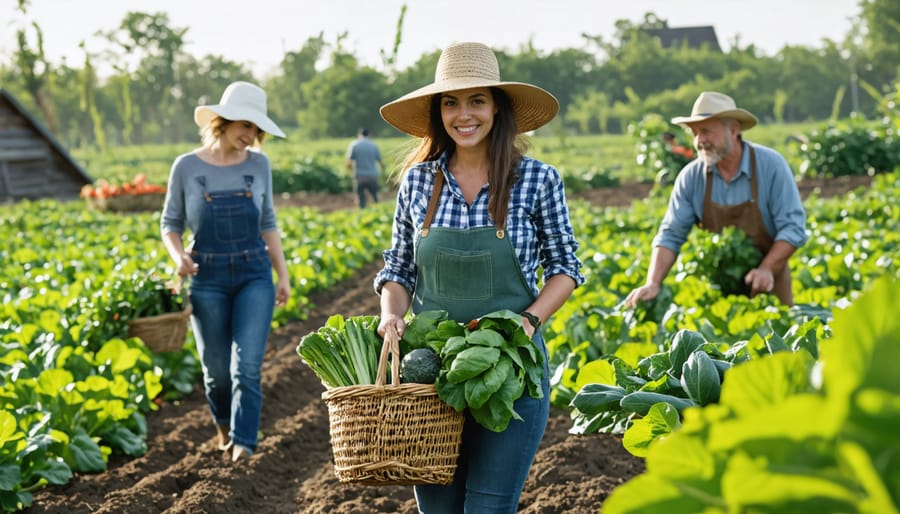
Environmental Impact and Carbon Benefits
Soil Health Improvements
Over the past five years, our community-supported agriculture project has documented significant soil health improvements through regular testing and monitoring. Organic matter content has increased from 2.3% to 4.1%, significantly enhancing the soil’s water retention capacity and nutrient availability.
The implementation of cover cropping and crop rotation has led to a measurable increase in beneficial soil microorganisms, with earthworm counts rising by 300% since project inception. Our soil structure has notably improved, with aggregate stability tests showing a 45% increase in soil particle cohesion, making our fields more resistant to erosion and better able to support robust root systems.
Biodiversity surveys conducted by the University of Alberta’s Agricultural Sciences Department revealed a 200% increase in beneficial insect species, including native pollinators and predatory insects that help with natural pest control. The diversity of soil fungi has also expanded, with mycorrhizal associations now present in 80% of our tested root samples, compared to just 30% when we started.
These improvements have translated into practical benefits for our member farmers, including reduced irrigation needs by approximately 30% and decreased fertilizer requirements by 40%, resulting in both environmental and economic advantages for our community.
Climate Resilience Metrics
Through careful monitoring and data collection, our CSA project has demonstrated significant environmental benefits that contribute to climate resilience. Over a three-year period, soil organic carbon increased by 2.3% across participating farms, translating to approximately 5.6 tonnes of carbon sequestration per hectare annually.
Water conservation metrics show a 35% reduction in irrigation needs compared to conventional farming methods, achieved through mulching and improved soil structure. This is particularly significant for Alberta’s semi-arid regions, where water management is crucial.
Biodiversity assessments revealed a 40% increase in beneficial insect species and a 25% rise in native bird populations. These improvements have led to natural pest control, reducing the need for chemical interventions by 60%.
The integrated livestock component has decreased external fertilizer requirements by 45%, while producing 2.8 tonnes of organic compost per hectare yearly. This circular system has resulted in a 30% reduction in overall greenhouse gas emissions compared to traditional farming operations.
Energy efficiency improvements, including solar-powered irrigation systems and passive greenhouse designs, have cut fossil fuel consumption by 25%. The local distribution model has reduced transportation emissions by an estimated 75% compared to conventional food supply chains.
These metrics are regularly shared with CSA members through quarterly reports, helping them understand their direct contribution to environmental stewardship while supporting local agriculture.
Implementation Blueprint
Initial Planning and Community Engagement
Before launching a community-supported agriculture (CSA) program in Alberta, thorough planning and community engagement are essential first steps. Start by conducting a local market analysis to understand the demand for fresh, locally-grown produce in your area. Survey potential members through community meetings, social media, and local farmers’ markets to gauge interest and gather feedback on preferred produce varieties.
Connect with established Alberta farmers who run successful CSA programs to learn from their experiences. Many are willing to share insights about pricing structures, membership sizes, and seasonal planning that work well in our climate. Consider partnering with local agricultural extension offices, who can provide valuable guidance on crop planning and business development.
Build relationships with community organizations, local food banks, and farmers’ markets to create awareness and establish potential partnerships. Host farm tours and information sessions to help potential members understand your farming practices and vision. This transparency helps build trust and creates a strong foundation for long-term community support.
Remember to assess your farm’s capacity realistically, including available land, water resources, and labour requirements. Start small with a pilot program of 15-20 members to test your systems before expanding.
Legal and Financial Framework
Most successful CSA operations in Alberta begin as sole proprietorships or partnerships, later transitioning to incorporated entities as they grow. When establishing your CSA, consult with an agricultural accountant familiar with local regulations to determine the most advantageous structure for your situation. Common options include non-profit cooperatives and limited liability corporations, each offering distinct tax benefits and member participation models.
Membership agreements should clearly outline share costs, payment schedules, and delivery commitments. A typical full-share membership in Alberta ranges from $500 to $800 per season, with flexible payment plans available. Consider offering various financial support programs such as sliding-scale pricing or work-trade options to ensure accessibility for diverse community members.
Insurance requirements include general liability coverage and crop insurance. Many CSAs also implement member agreements that acknowledge shared risks and benefits, protecting both farmers and participants while fostering community investment in the farm’s success.
Technical Design and Species Selection
In selecting species for Alberta’s challenging climate, our community farm prioritizes hardy varieties that can thrive in Zone 3 conditions. We’ve had particular success with Saskatoon berries, haskap, and Evans cherry trees, which provide reliable yields even during shorter growing seasons. These native and adapted species require minimal irrigation once established, making them ideal for our water conservation goals.
For the understory, we’ve incorporated drought-resistant herbs like sage, thyme, and oregano, which serve multiple functions in our food forest system. Cold-hardy vegetables, including kale, root crops, and various brassicas, round out our seasonal offerings to CSA members.
Our design incorporates windbreaks using native white spruce and trembling aspen, protecting more delicate crops and creating beneficial microclimates. We’ve arranged our plantings in strategic guilds, with taller species on the north side to maximize sunlight exposure for shorter plants.
Through careful species selection and placement, we’ve created a resilient system that produces food consistently while supporting local biodiversity. This approach has proven particularly effective in managing the temperature fluctuations and limited precipitation typical of our region.
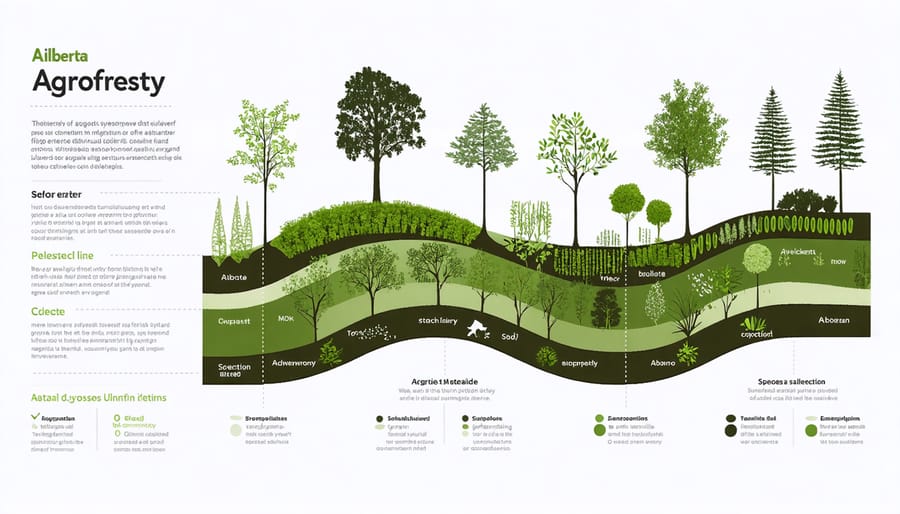
Community-supported agriculture represents a transformative opportunity for Canadian farmers to build resilient, sustainable operations while strengthening local food systems. As we’ve seen through successful examples across Alberta, this model offers multiple benefits: stable income through pre-season memberships, reduced market uncertainties, and meaningful connections with community members who share in both the risks and rewards of farming.
For farmers considering this path, the time to act is now. Climate-conscious consumers are increasingly seeking local food options, and the demand for CSA programs continues to grow across the prairie provinces. Start by assessing your farm’s capacity and developing a detailed plan that aligns with your community’s needs. Consider reaching out to established CSA farmers who can provide valuable insights and mentorship.
Remember that success in community-supported agriculture isn’t just measured in yields and profits. It’s about creating a sustainable food system that benefits everyone involved. Whether you’re managing a small family farm or a larger operation, the CSA model can be adapted to suit your circumstances.
Take the first step by attending local agricultural workshops, connecting with regional farming networks, and engaging with potential members in your community. The transition may require adjustment, but the rewards – both for your farm’s sustainability and your local community – make it a worthwhile endeavour. Your journey toward community-supported agriculture could become the next success story inspiring fellow Canadian farmers.


